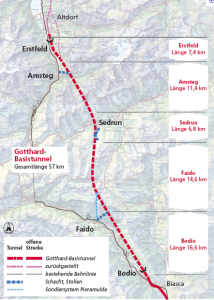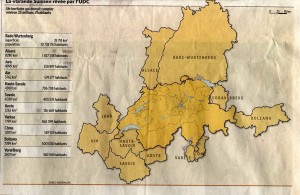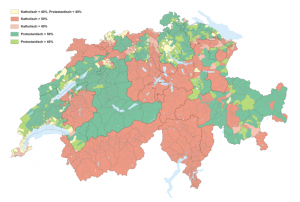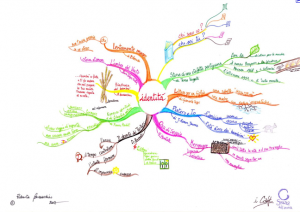Open Cities 24 Identity as closure?
What is stirring the minds and hearts in Switzerland is fascinating. The centre of attention is an initiative by a politician, Christoph Blocher, a rich industrialist who is making his money with factories staffed by foreign female labour. He is head of the ultra right wing party, the Swiss People Party (SVP/UDC), which is relentlessly gaining power by surfing on a xenophobic wave, a contradiction which does not seem to disturb Blocher in any way.
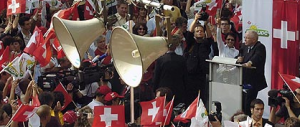
dia1 Christoph Blocher at political rally source:http://muslimah786tracasserie.blogspot.com/2009/08/switzerlands-neo-nazi-right-wing.html
He had been de-booted from the top of the political tree as a Federal Councillor, the highest office in Switzerland, but that does not distract him from seeking a political come back. His current wrath is aimed at the European Union. His proposal is to incorporate a clause in the Swiss Constitution which shall prevent the country for ever to adhere to the European Union – even the European Economic Area – while other parties are trying to revive a debate on a realistic relationship between the EU and Switzerland.
Identity and boundaries
Why is this relevant to the Open Cities debate? If a country at the geographic heart of Europe would pull up its drawbridges such a gated island would obstruct pan-European communications. In reality, Switzerland is investing millions in a better tunnel under the Alps linking Germany to Italy by rail to avoid pollution from increasing freight transport across Europe. Similarly, its high speed rail network is totally integrated in the EU TEN network and its motorways lead seamlessly to France, Germany, Austria and Italy.
Conversely, another DVP/UDC politician on the national council has if not an open then an expansionist view of Switzerland. He proposes that likeminded cultural ‘cousins’ surrounding Switzerland could get into its fold. His vision reaches out to some 25 million people, as opposed to less then 8 million inhabitants of Switzerland to become part of Switzerland as new cantons and turn their back on Europe. This reminds of a map in a Torún museum tracing the outermost borders of Poland compounded across history, another way of affirming expansionist ‘identity’ in space.
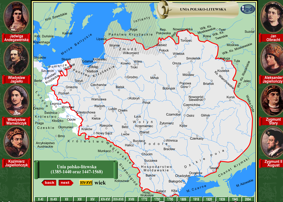
dia 4 Snapshot of constantly changing Poland, including three times eradication source: polmap.republika.pl (interactive maps).
Socio-economic openness
Switzerland’s identity is cosmopolitan though. From a humanistic point of view, Switzerland has a history of asylum (e.g. Pestalozzi village). Inhabitants of foreign origin make up over twenty-one percent (in 2007) and rising in the context of growing population and increasing naturalisation. Moreover, a large percentage of the workforce in Basle and Geneva are commuters from France and Germany and many Italians have second homes in Ticino, the Italian speaking part of Switzerland. Immigrants do not only consist of very rich tax exiles but make up a large part of the workforce. Universities have a very open policy regarding staff, cooperate in many international research ventures and participate fully in EU exchange and study mobility programmes.
Contradictions of identity and diversity
Internally, Switzerland is very diverse. For example, it hosts many religions. Yet an official map locating several religions omits Islam, although Muslims amount to some 400,000 in 2009, i.e. 5% of the population.
It has four official languages. The French speaking part is usually considered more inclusive, more open to influx, more ready to cooperate and negotiate. The much smaller Italian speaking part has always been turned toward Italy, not least as it is separated by the Alps from the rest of Switzerland. The Romansh speaking part is confined to some mountain valleys, while the largest part consists of Swiss German speaking cantons and cities where dialects vary almost from place to place. A recent groundswell, endorsed by politicians and celebrities, is demanding better recognition and greater use of local dialects as a mark of identity which, in turn, may create ever more localised differences, fragmentation and possibly exclusion.

dia 6 ‘Them and us’ perception source:http://muslimah786tracasserie.blogspot.com/2009/08/switzerlands-neo-nazi-right-wing.html
Switzerland presents an interesting example of both closure and openness and all the contradictions this entails. By definition belonging to an identity, be it cultural, spatial, political or whatever, means inclusion for those who form part of such entities and exclusion for the others. Is Swiss diversity conducive to foster openness within its borders and – a forciori – beyond its national boundaries? How can openness work in these circumstances and how does it manifest itself as regards physical and mental borders? What lessons can be drawn from the constant debate about the right to identity down to nuances of dialect for tolerance with others and openness to broad, supra-national causes?

